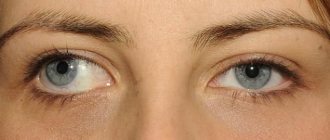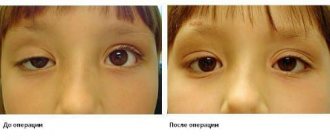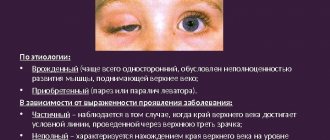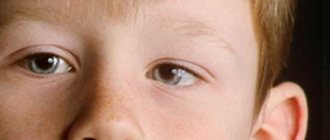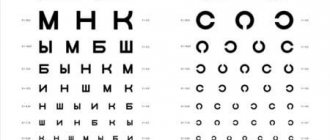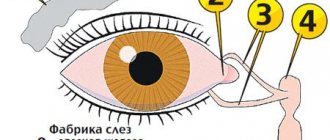Signs of strabismus
Strabismus (the medical term used to describe strabismus) is characterized by the deviation of one or both eyes from a common point of fixation. In addition to the visual defect, this also entails a violation of binocular vision, that is, the ability to perceive an image with two eyes at the same time.
Normally, the human brain perceives pictures received from both eyes, analyzes and combines them. As a result, a person sees a three-dimensional image, which allows him, for example, to correctly estimate the distance to surrounding objects.
With strabismus, the brain receives two different images that it cannot combine. As a result, the “picture” before the eyes may double, or the image received from one of the eyes is simply suppressed by the brain.
In this case, a person cannot correctly estimate the distance and perceives the world distortedly; over time, the eye, the image from which is suppressed by the brain, loses visual acuity. This leads to amblyopia, that is, lazy eye syndrome, in which one eye does not participate in the visual process. Therefore, strabismus requires constant monitoring by a specialist.
Sign up for a free vision test
The eyes can deviate up or down (hyper- and hypotropia), outward, that is, towards the temple (exotropia), and also inward, that is, towards the bridge of the nose (esotropia).
Manifestations in adults
Most often, strabismus in an adult is a consequence of an untreated illness from childhood. This is due to congenital pathologies, as well as injuries to the visual organ received at an early age.
Sometimes the primary symptoms can be headaches and eye pain. However, most often, strabismus is visible with your own eyes, by the location of the eyes relative to each other.
Visually, strabismus manifests itself in the squinting of one eye in the opposite direction vertically or horizontally relative to the straight-looking second eye. In medical terms it looks like this:
- Hypotropia. The eye is turned downwards.
- Hypertropia. The eye is turned upward.
- Exotropia. The eye is turned outward.
- Esotropia. The eye is turned inward.
Based on this classification, three types of strabismus are distinguished:
- convergent - when one of the eyes squints closer to the nose;
- divergent - when the eye squints towards the temple;
- vertical - the eye squints up or down.
Also, a separate type of disease can be identified as imaginary strabismus or “heterophoria”. A patient with such a vision disorder squints his eye only if the healthy eye encounters an obstacle to perception. For example, a flap or a card. In the absence of obstacles to a healthy eye, a person sees well and does not experience difficulties in perception.
Types of strabismus
Strabismus is divided into:
- True;
- Imaginary - normally the maximum angle between the optical and visual axis is 4°, but if there are specific structural features of the eyes, the discrepancy between the axes may exceed the norm, which is noticeable from the outside. If binocular vision is preserved, such strabismus is considered imaginary and does not require treatment. To put it simply, outwardly it looks like strabismus, but it does not entail the vision problems characteristic of strabismus. Sometimes asymmetry of the face or eye orbits can be the cause of imaginary strabismus;
- Hidden strabismus - in this case, the extraocular muscles act asymmetrically, as a result of which the eye may deviate. Most often this happens in moments of relaxation, that is, when a person is not fixated on anything. As a rule, binocular vision “turns on” as soon as a person focuses his gaze on something, and the eye returns to its place. In this case, strabismus does not interfere with full visual perception; accordingly, it does not require treatment. However, if the degree of deviation of the eye is significant, it can cause increased visual fatigue and headaches. In this case, special glasses and sometimes surgery may be prescribed for correction.
It is important to begin observation by an ophthalmologist as early as childhood.
Clinical manifestations of vertical strabismus
Hypertropia and hypotropia are clearly distinguishable because they are manifested by asymmetry, which is clearly visible to the naked eye. Clinical manifestations are as follows:
- diplopia or double vision, in which the image appears in two;
- frequent headaches and dizziness;
- cyclotorsional deviation of the eyes (from rotation around the visual axis);
- turns the head depending on the direction of gaze.
If we are talking about a child, parents need to pay attention to how he holds his head. Very often, with vertical strabismus, the baby involuntarily tilts it to the side. The easiest way to notice this is when he is looking at toys or watching TV. Other signs may include increased sensitivity to bright light and an inability to correctly judge the distance of objects.
Diagnosis of strabismus
The disease is diagnosed by external examination and can be noticed even by a layman. The exception is a hidden violation. Although it can also be noticed from the outside when a person is not focused on anything, more often hidden strabismus is diagnosed using special tests at an ophthalmologist's appointment.
The diagnosis of strabismus is made only after a comprehensive medical examination
When testing a patient for hidden strabismus, the specialist performs binocular vision tests. Using these tests, you can not only diagnose strabismus, but also refute its presence if the patient has an imaginary defect.
Sign up for a free vision test
Strabismus in children. Not just a cosmetic defect!
In some cases, strabismus is detected at birth, but, as a rule, this occurs no earlier than 3-6 months, when the child can already concentrate his gaze on any object.
Vision problems are noticed by parents or other close people who notice that one of the child’s eyes is “squinting”, his eyeballs cannot move synchronously... A slight strabismus can often only be determined by an ophthalmologist during an examination because Outwardly it is almost invisible.
Some parents think that strabismus is a purely external (cosmetic) defect. In fact, a “strange”, painful look with strabismus is far from the main problem.
| Every 14 days, clinic employees are tested for coronavirus infection. | Before the start of the working day, each employee's temperature is taken. |
| Medical staff use medical masks, gloves, disposable gowns and caps, which are changed every two hours of work. | Upon entry, all patients’ body temperatures are measured, hands are sanitized, and clean disposable masks and gloves are offered. |
| The time intervals between registered patients have been increased. There are no more than 10 people per 300 square meters in the clinic at the same time. | Sanitary safety measures have been strengthened. Not only the surfaces of work rooms, but also all areas of the clinic are regularly treated and disinfected. |
Treatment of strabismus
Before prescribing treatment, the ophthalmologist performs additional testing to determine:
- The nature of strabismus - one or both eyes are susceptible to the disease;
- View - in which direction the eye deviates;
- The magnitude of the deviation;
- The degree of impairment of binocular vision.
Only on the basis of this data can the correct treatment be selected.
The sooner you start correcting strabismus, the more effective results you will achieve. That is why it is better to start treatment of congenital strabismus in childhood. Typically, treatment includes the following methods:
- Occlusion, that is, closing one eye (using a patch, an opaque lens, or a special spectacle shield), is often used in preparation for surgery;
- Orthoptics
, that is, hardware treatment aimed at developing the correct connection between binocular vision and the brain; - Surgery is the most effective treatment method, which allows you to restore a normal angle of vision. Sometimes several operations may be needed before the defect is corrected. After surgical treatment, therapeutic restoration of binocular vision will be required;
- Diploptics is a therapy aimed at developing binocular vision.
However, be prepared for the fact that treatment for strabismus may take several years.
Adults can completely get rid of strabismus only after surgery, supplemented by therapeutic treatment. However, vision can be corrected in case of strabismus with the help of glasses. Properly selected optics will also help to outwardly hide the defect from others.
In childhood, strabismus can be corrected using conservative methods; adults require surgical intervention
OPERATING PRINCIPLE:
The action is based on partial separation of images into visual branches using spectral glasses. Each filter covers the field of view of one eye. If you look through a blue filter, you can see a contrasting black sample image and a low-contrast ornament around the perimeter of the picture. Through the red filter, the sample image is practically invisible, and the ornament around the perimeter of the picture has a rich black color. During the training process, you should reproduce the sample image and make it visible through the red filter. To do this, use a dark felt-tip pen to outline the drawing, which is visible through the blue filter. Moreover, what is drawn is not visible through a blue filter! After all, the sample image is already black.
Selection of glasses for strabismus
In this case, glasses are aimed primarily at eliminating existing visual impairments - myopia, farsightedness, astigmatism. Special optics can also have a therapeutic effect, but squint cannot be cured with glasses.
Special lenses are used to correct the defect using glasses. Their selection is carried out by an ophthalmologist.
Prismatic lenses
Such lenses are recommended for true or hidden strabismus. They stimulate the training of weakened eye muscles and help in correcting the angle of vision.
Prismatic lenses have a unique structure: one side of the lens is thick, the other is beveled. Exactly which part of the lens will be thickened directly depends on the type of strabismus.
Glasses with such lenses are suitable for regular use.
Fresnel prisms
This type of optics consists of thin plastic plates that are attached to the back of spectacle lenses. For those around you, the presence of Fresnel prisms is almost invisible.
The plates have a structure similar to prismatic lenses. They are effective in restoring binocular vision, but they cannot cure strabismus. Since the pads are attached to the patient's main glasses, they can also be used permanently.
The comfort of a person with strabismus will largely depend on correctly selected optics. Therefore, it is important not to self-medicate or ignore the problem, but to contact a specialist in a timely manner!
Find your nearest optical store
Correct glasses
If you have squinting eyes, you can choose glasses with tinted lenses. It is not necessary that they be completely black; it is better to give preference to a model with translucent lenses. These glasses do not hide your gaze from your interlocutor, but at the same time make squint less noticeable. They can be worn both outdoors and indoors.
Options with anti-reflective coating are perfect for photography - your problem will not be noticeable in the photographs. Anti-glare glasses have other advantages: they make your eyes less tired when working at a computer.
EXPLOITATION:
Training should begin with simple drawings and, as you gain skills, move on to more complex drawings with small details. For drawing, you should use permanent markers that can write on glossy surfaces without forming small droplets. The color of the felt-tip pen is almost any, but quite saturated (black, blue, green), just not red. The thickness of the line for working with complex patterns should not exceed one or two millimeters. To reuse an already colored drawing, the felt-tip pen can be wiped off with a cloth soaked in alcohol.
